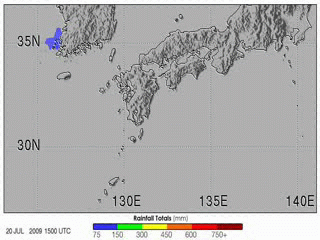Berkas:Heavy Rains in Southern Japan.gif
Heavy_Rains_in_Southern_Japan.gif (320 × 240 piksel, ukuran berkas: 8,35 MB, tipe MIME: image/gif, melingkar, 268 frame, 8,0 d)
Riwayat berkas
Klik pada tanggal/waktu untuk melihat berkas ini pada saat tersebut.
| Tanggal/Waktu | Miniatur | Dimensi | Pengguna | Komentar | |
|---|---|---|---|---|---|
| terkini | 31 Juli 2009 21.56 |  | 320 × 240 (8,35 MB) | Originalwana | {{Information |Description={{en|1=The 2009 summer monsoon brought torrential rains to south western Japan in July. This animatin shows rainfall estimates for southern Japan and the surrounding region from July 20–27. The most prominent feature is a larg |
Penggunaan berkas
Halaman berikut menggunakan berkas ini:
Penggunaan berkas global
Wiki lain berikut menggunakan berkas ini:
- Penggunaan pada cs.wikipedia.org
- Penggunaan pada en.wikipedia.org
- Penggunaan pada fi.wikipedia.org
- Penggunaan pada ja.wikipedia.org
- Penggunaan pada ms.wikipedia.org
- Penggunaan pada si.wikipedia.org
- Penggunaan pada te.wikipedia.org
- Penggunaan pada uk.wikipedia.org
- Penggunaan pada vi.wikipedia.org
- Penggunaan pada www.wikidata.org
- Penggunaan pada zh.wikipedia.org



